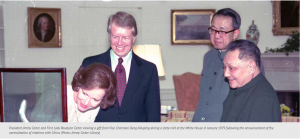
On December 15, 1978, U.S. President Jimmy Carter announced the establishment of formal diplomatic relations, set to begin on January 1, 1979, between the U.S. and China. The U.S. recognized the communist People’s Republic of China as the government for the country and ended its formal diplomatic relationship with the nationalist Republic of China, based in Taiwan. This followed months of secret negotiations led by Secretary of State Cyrus Vance and National Security Advisor Zbigniew Brzezinski for the United States and Vice Premier Deng Xiaoping for China.
Taiwan’s Vice Foreign Minister Frederick Chien said he felt the United States . was turning its back on previous promises made to assist and defend the Taiwanese. The concern was that the communist People’s Republic of China had too much influence over the United States, which “yielded” to communist demands. Taiwanese President Chiang Ching-kuo expressed concern over the possibility of the People’s Republic of China attempting to increase tensions between the United States and the Soviet Union. President Chiang also worried about increased communist influence within the United States and diplomatically, with the People’s Republic attempting to isolate the United States.
The timing of the announcement was no accident. First, Carter wanted the announcement to come after the midterm elections in 1978. There was still a strong body of support in the United States behind Taiwan and many congressmen were highly critical of Carter’s decision. These Taiwanese supporters agreed with Taiwan’s leadership and saw the withdrawal of diplomatic relations as the United States turning its back on Taiwan. They also worried about communist influence in the region, especially potential military threats. In April 1979, Congress passed the Taiwan Relations Act, establishing diplomatic relations on a non-formal basis, allowing for the sale and trade of arms to support Taiwan.
Carter thought the announcement of U.S. relations with the People’s Republic of China would be a beneficial precursor to the second round of talks with the Soviet Union following the first Strategic Arms Limitation Talk in 1972. Former U.S. President Richard Nixon had started talks with the People’s Republic of China as a means to ease tensions between the U.S. and the Soviet Union. He hoped that by establishing relations with the communist Chinese government, the Soviet Union would want to improve their own relations with the United States. and Carter was continuing this strategy. Fear of nuclear war was also still present, so Carter hoped passing arms limitations would ease those fears. Finally, China was a potentially lucrative market for American businesses, and establishing diplomatic ties would go far in opening the market for future investment.
Coverage of Carter’s move to establish diplomatic ties with the People’s Republic of China was met with hostility by the New York Times. The Times said Carter guaranteed himself an “assortment” of political opponents while questioning the timing of his decisions, calling them “sudden.” The Times also noted that the move by the U.S. was seen as “soft” by some European allies. With economic problems at home, the Times specifically highlighted inflation, members of the U.S. public were quite unhappy with President Carter. These negative feelings were exacerbated by this move because so many were still fervently against communism and were adamant about the United States’ longstanding support of Taiwan.
Bibliography
Campbell, Craig, and Logevall, Fredrik. America’s Cold War: The Politics of Insecurity. Cambridge, MA: Harvard University Press, 2009.
Leffler, Melvyn P. For the Soul of Mankind: the United States, the Soviet Union, and The Cold War. New York: Hill and Wang, 2008.
Mitchell, Nancy. “The Cold War and Jimmy Carter.” In The Cambridge History of the Cold War, eds. Melvyn P. Leffler and Odd Arne Westad, The Cambridge History of the Cold War. Cambridge: Cambridge University Press, 2010: 66-88.
Reston, James. “No Happy Year For Jimmy.” New York Times, Dec 17, 1978. E20.
